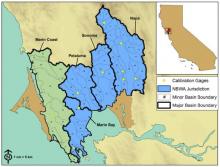Downscaling future climate projections to the watershed scale: a North San Francisco Bay Estuary case study

We modeled the hydrology of basins draining into the northern portion of the San Francisco Bay Estuary (North San Pablo Bay) using a regional water balance model (Basin Characterization Model; BCM) to estimate potential impacts of climate change at the watershed scale. The BCM calculates water balance components including runoff, recharge, evapotranspiration, soil moisture, and stream flow based on climate, topography, soils and underlying geology, and the solar-driven energy balance. We downscaled historical and projected precipitation and air temperature values derived from weather stations and global General Circulation Models (GCMs) to a spatial scale of 270 m. We then used the BCM to estimate hydrologic response to climate change for four scenarios spanning this century (2000-2100). Historical climate patterns show that Marin’s coastal regions are typically on the order of 2 °C cooler and receive five percent more precipitation compared to the inland valleys of Sonoma and Napa due to marine influences and local topography. By the last 30 years of this century, North Bay scenarios project average minimum temperatures to increase by 1.0 °C to 3.1 °C and average maximum temperatures to increase by 2.1 °C to 3.4 °C (in comparison to conditions experienced over the last 30 years, 1981-2010). Precipitation projections for the next century vary between GCMs (ranging from 2 to 15% wetter than the 20th century average). Temperature forcing increases the variability of modeled runoff, recharge, and stream discharge, and shifts hydrologic cycle timing. For both high and low rainfall scenarios, by the close of this century warming is projected to amplify late season climatic water deficit (a measure of drought stress on soils) by 8-21%. Hydrologic variability within a single river basin demonstrated at the scale of subwatersheds may prove an important consideration for water managers in the face of climate change.
Please see the related work:
Adapting to Climate Change State of the Science for North Bay Watersheds: A Guide for Managers
Micheli, E., L. Flint, A. Flint, S. Weiss, and M. Kennedy. 2012. Downscaling future climate projections to the watershed scale: a North San Francisco Bay case study. San Francisco Estuary and Watershed Science 10(4).

Comments
Deanne DiPietro
Thu, 2012-01-05 16:27
Permalink
Example methodology for use of the Flint BCM data
This paper presents a practical application of the BCM datasets in a watershed-based analysis of water resource vulnerability under two climate change future scenarios and discusses possible water management interpretations of the variability seen in the projections, offering useful insight for managers.
Deanne DiPietro, Conservation Biology Institute
deanne.dipietro@consbio.org